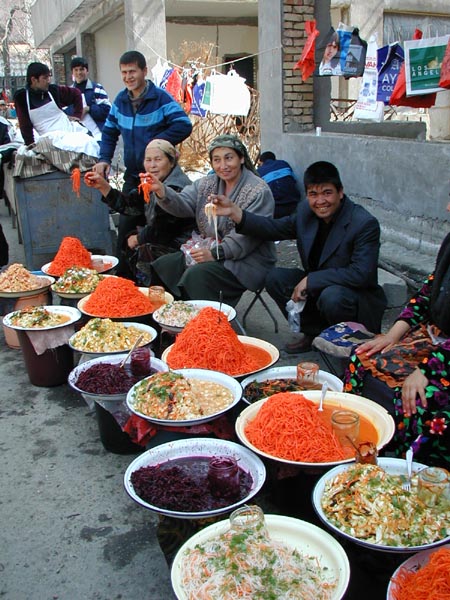|
There
are currently 150 Ubec students enrolled. They dress alike in black
suits with white shirts.The school is two stories high with rooms
opening onto a square grassy area that has fine gravel paths, a small
pond and a few trees. Plaques are mounted at each doorway entrance with
sayings by Mohammed, such as “Whoever learns science then God will make
the road to heaven easy”.
We
ended our tour at their gift shop where we were encouraged to make a
purchase “to remind us of our visit to the Madressa”.
We
were given an orientation of the Corsu Market and some time to shop
before meeting on the bus at 1:30 pm. It was a very lively place and
everyone was very friendly, wanting to give us samples and have their
picture taken. The tables were laden with all sorts of food; with bags,
boxes and sacks stacked in piles. There was a florist area and upstairs
a clothing department. We went outside to the small shops and made some
memorable purchases there.
Our
lunch was at the Turkish Center (downstairs) which was self-serve; a big
decision as most of our meals are arranged for us.
We
then walked through an amusement park and a street of stalls which were
selling souvenirs (carved boxes, jewellery, et.). This led to the
Monument Statue of Amir Timur on horseback. The Intourist Hotel
Uzbekistan was to the east. In the Monument Park many of the trees are
more than 100 years old. When Uzbekistan gained independence in 1991,
Amir Timur became a symbol of their independence.
We
were back on the bus at 3:05 pm.
Next
we visited the Abdul Khasim Madress which was given to crafts people.
Many orphans from the USSR came here to learn a craft. This madressa is
also arranged around a central courtyard with small shops and workshops
of artists. We saw many art works including paintings, painted boxes,
carved boxes and bookstands, etc, etc, etc. and were able to make some
purchases to take home.
We then traveled
to The Museum of Applied Arts which was originally designed as a home by
Alexander Polovtsev, a wealthy diplomat in 1905. In 1935 it became the
Museum of Applied Arts. Unfortunately the area which contained the hand
embroidered Suzanis was closed for renovations so we were unable to view
these. We did look into the section where jewellery and machine-made
Suzanis were displayed. The gift shop was also open (so more shopping
was accomplished).
While traveling
around the city Utkir pointed out many Parks, buildings Ministries and
Embassys, etc, etc. Most Uzbec homes are one story with a high fenced
and gated yard. Another highlight visit for us was to one of the more
important Artists in Uzbekistan. The 5th Generation
Potters: “The Golden Clay” Akbar and Alisher Rakhimov. Upon entering
the central courtyard of their home and workshop built by Alisher’s
Grandfather we were told there were Pomegranate, Persimmon and Fig Trees
as well as Grapes growing there.
The Grandfather’s
Workshop is now made into a Museum. When he was 20 years of age he went
to Moscow to study. He also worked extensively with archeologists to
find out the different styles and dyes of past centuries, ie 13th
Century Cashkar, Uzbec, Samarkand, Needle and Buchara Styles. He also
worked in architecture tiles for restoration projects for the 15th,
16th and 17th Centuries. He used to prepare his
own glazes by using ask from plants. He wrote two books in Russian on
the colors, glazes, ornaments, designs and symbols. These books are to
be translated into different languages for potters reference. In 1933
his workshop was closed. The family has the Grandfather’s diaries and
writings which they are now following. Akbar Rakhimov is continuing the
legacy of his father. He has had creative training journies abroad,
particularly to Japan. His innovations and borrowings remain in the
traditional national character of the Uzbec ceramics. His items were
displayed in Saint Petersburg (1991), Bonn, Germany (1992), Solo display
in Kago, Japan (1997), Tashkent Solo Displays in 1994, 1996 and 1997.
In 1995 he was awarded UNESCO’s diploma and certificate as one of the
best ceramics masters in Uzbekistan. His works were widely represented
in his solo display “The Great Silk Road” in 1998.
Akbar’s son,
Alisher was a student of the National Institute of Arts and Design and
participated in a number of Expositions and displays of the applied arts
and is continuing his father’s tradition. Alisher showed us the display
of both his father and his work which we were able to purchase.He showed
an artist’s sketch of a building they are planning that will be a
school, studio and potter association. It will have exhibition, lecture
rooms and a library where potters can come to learn and exchange ideas.
The building will use a traditional architectural style. After our tour
Alisher served us tea and cakes in the garden. He said his was a very
interesting kind of life. When we left, his little son came out to wave
goodbye.
Our dinner was at
the hotel at 7:30 p.m. The end of another full and very interesting
day. |


